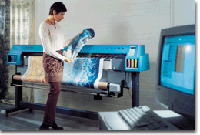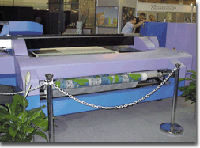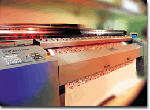Tecno TMA TextilBy Pier Guiseppe Bullio, European Correspondent
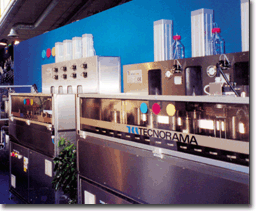
Bologna Fair Acquires International Flair
Tecno TMA Textil 2001 offered excellent chance to make, seal deals. With the only,
though undeniable, limit of being a fair that is substantially aimed at the knitting sector, Tecno
TMA Textil in Bologna, Italy, became a truly international affair this year.A lot is said and
written about exhibitions, and much of it is frequently far from favorable, often not without good
reason: there are too many fairs; they cost too much; they absorb excessive company resources (in
terms of people and means); too often, the number of visitors is insufficient; and those who come
lack interest and are not professionally prepared.The list could carry on, with dates failing to be
ideal, and host towns lacking the background of an attractive market.But at the same time, it is
evident that, especially for the textile machinery industry, a machinery exhibition that is
well-organized in terms of place, times and marketing (aimed not only at exhibitors but also at
visitors) remains a means of communication for manufacturing and trading companies. It also offers
an opportunity to sow seeds and an unrivaled chance to set up or seal deals, especially for small
or medium size companies.These benefits apply especially to the category of exhibitors that can
reap considerable additional advantages, such as the opportunity to compare their products with
those of larger competitors or to contact agents and representatives for new areas. More generally,
these exhibitors are able to view the general situation of the sector, drawing some often
inspirational ideas from a discreet glance at other operators exhibits.For visitors, on the other
hand, there is no more convenient, faster and safer system for comparing the best products in a
particular segment. On some occasions, a few hours suffice in order to make a choice, guaranteed by
the fact that potential suppliers are all gathered under the same roof just a few meters apart. So
the knitting mill from Carpi, the finisher from Prato and the dyer from a small woolen mill in
Biella find they have the same chance to examine and select products as managers from larger groups
(for example, Benetton, Marzotto, Zucchi, Miroglio and others), who are regularly visited by
salesmen from major manufacturers.Therefore, the conclusion is disarmingly simple: when a fair is
well-organized, highly specialized, and truly international, the opportunity exists to provide
maximum satisfaction for both exhibitors and visitors.The sting, however, is that exhibitions that
really meet these basic requirements are becoming increasingly rare. Fairs such as INDEX,
Techtextil and FAST meet these standards, all three of them being pipeline fairs, and therefore
somewhat different from conventional textile machinery exhibitions. The directors of the Italian
Association of Textile Machinery Manufacturers (ACIMIT) came to this same conclusion on returning
from ITMA 99 in Paris after the decision to move to Birmingham in autumn 2003.Deciding to set aside
the gentlemens agreement that has been in force for decades, according to which the national
associations of the eight member countries of The European Committee of Textile Machine
Manufacturers (CEMATEX) would not hold competing events on their own territory, ACIMIT decided to
compete wholeheartedly by developing existing machinery fairs in Italy. ACIMIT
InitiativesExcluding the so-called local fairs, such as the latest held in Busto Arsizio and
Biella, as well as niche events, which are not influential for the majority of associates, the
choice remained to reinvigorate long-standing fairs FAST in Verona and Tecno TMA Textil in Bologna.
In Verona, there were no extraordinary needs. FAST is a fair for hosiery machinery, a sector in
which Italian manufacturers are unrivaled leaders on the market, holding more than 80 percent of
the world market. The great relaunch of Tecno TMA Textil was a more involved affair. The fair has
good tradition to its credit, but it still lacked credentials for being truly international. The
efforts based on modern ideas and large investments systematically made by Bologna Fiere, ACIMIT
and the Italian Trade Commission (ICE) combined to hit the mark and render the event convincing.
Indeed, during the five days of the fair at the end of May, and due to a significant increase in
the number of exhibitors, exhibition spaces and visitors, the managers of the three organizing
bodies met with significant success.The fair was lively, interesting and rich with innovative
products; and run by a highly professional staff in the lavish stands. The fairs image was also
well-thought out it attracted a crowd of interested and professionally qualified specialists, many
of whom came from abroad.The chairman of ACIMIT, Alberto Maria Sacchi, said he was very pleased.
His company, HTP Unitex, was an exhibitor at the fair. [There have been] numerous visitors, with
articulated and concrete needs; many new contracts that will certainly prove interesting in the
short term; positive confirmation from important professionals we met, he commented. We have reason
to be satisfied!
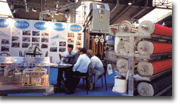
Obem booth at the show.
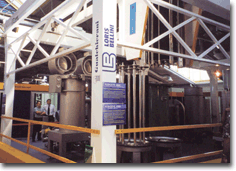
A synergy of roles between Loris Bellini and Gualchierani in dyehouse automation. Sacchi
was also a protagonist in the additional events that ran parallel to the fair. He participated as a
speaker at the congress organized to highlight the importance of the Italian textile machinery
industry to support Italian fashion as a world leader.Sacchi once again underlined the value of
integration between the two categories of manufacturers and textile specialists (their customers
and partners). These two sectors have, especially recently, set up intense and convincing forms of
collaboration in developing new machinery, equipment and production technology with concrete,
important and enviable results.From other speakers, a clear picture of the current market situation
on a world level also emerged. On the whole, orders for manufacturers are slowing down, and for
many, this situation has meant meeting (finally) delivery times after months of frantic production,
leading to inevitable delays.The fact would be worrying if it were not for two precise
circumstances related to high-level economic policies, both of which should soon disappear. In
Italy, it is no mystery that the wait for a new Tremonti law (which will create new tax advantages
for companies) has practically frozen many orders that were only a step away from a successful
conclusion. The law is expected to come into force within the next few months.On the other side of
the Atlantic, the United States is expecting a refuel from a tax reduction amounting to around $100
billion. This is an enormous amount even for the giant U.S. industry, which hopefully should as a
consequence return to full steam in the second half of 2001, dragging the entire world economy with
it. Furthermore, many of the textile operators interviewed had just come for the opening of the
fair, their plane ticket already safely in hand for China, where Shanghaitex 2001 was to open the
following Tuesday. China is in a period of substantial renewal of its textile plants, and has
almost doubled machinery imports from Italy in the past two years, purchasing at a rhythm that
alone could cover all the growth needs of the textile machinery industry. In the orders placed by
the Chinese, the most significant demand is for modern, reliable, versatile machines and systems,
especially those equipped to process fine fibers such as cashmere and silk. A Close LookAs
mentioned previously, one of the best-appreciated tangible advantages for all the participants at a
successful exhibition, which Tecno TMA Textil certainly was, is having the chance to meet a large
number of important operators and to profitably exchange opinions, information, experience and so
on.Exhibitors and attendees at Tecno TMA Textil were generally satisfied, but they were somewhat
restrained by the bounds of a limited presentation of the knitting sector. In particular,
professionals in the finishing segment said it was time at last for Italy to offer a large
exhibition to host all the sectors in the pipeline spinning, weaving and technical textiles
included.Naturally, for insurmountable reasons of logistics and district traditions, such an
exhibition would have to be held in the north of Italy, where the majority of spinners, weavers,
and cotton and woolen mills are based. This is an age-old problem, but a solution could be strongly
stimulated by two highly probable and contingent factors, the first being the low-profile forecast
for ITMA 03 in Birmingham.The second, which is making progress in this period, is the building of a
site external to the Milan fairgrounds. Once the problems of space and access are eliminated, the
project for a new high-level textile machinery exhibition could take shape, and certainly meet with
favor from foreign professionals.This conclusion was expressed by entrepreneurs and managers who
visited Bologna and whose credentials are unquestionable.
August 2001





